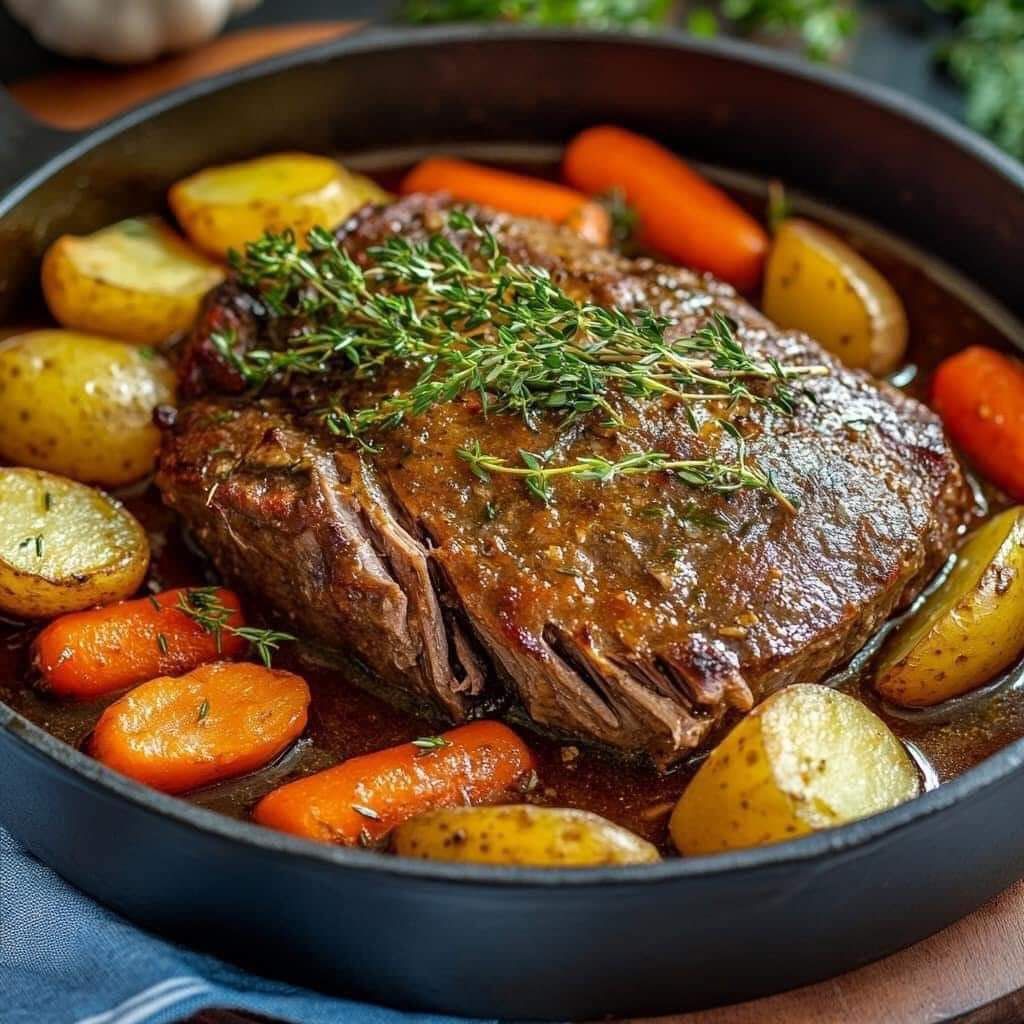ADVERTISEMENT
Ingredients :
3-4 lbs chuck roast1 lb Yukon Gold potatoes, cut into chunks4 large carrots, peeled and sliced1 large onion, chopped4 cloves garlic, minced2 cups beef broth1 cup red wine (optional)2 tbsp olive oilSalt and pepper to tasteFresh thyme and rosemary sprigs2 bay leaves
Préparations :
Preheat your oven to 300°F (150°C).If using a slow cooker, set it to low.Sear the Meat: Heat olive oil in a large, heavy-bottomed pot over medium-high heat. Sear the chuck roast on all sides until browned. Remove and set aside.Cook the Onions and Garlic: In the same pot, add the chopped onions and cook until softened. Add the garlic and cook for another minute.Deglaze the Pot: Pour in the red wine, scraping up any browned bits from the bottom of the pot. Let it simmer for a few minutes to reduce slightly.Add Vegetables and Meat: Place the potatoes and carrots in the pot or slow cooker. Lay the seared meat on top.Add Broth and Herbs: Pour in the beef broth, ensuring the liquid covers about half of the meat. Add thyme, rosemary, and bay leaves.Cook Low and Slow: If using an oven, cover the pot with a lid and cook for 3-4 hours. For a slow cooker, cook on low for 8 hours or until the meat is tender and pulls apart easily.Serve: Remove the bay leaves and herb sprigs. Slice the meat and serve with the vegetables and a generous ladle of the cooking liquid.Making the Perfect GravyCollecting Drippings for GravyAfter cooking, the pot will be filled with rich, flavorful drippings. Strain these to remove any large pieces of vegetables or herbs, leaving you with a smooth base for your gravy.Thickening Agents and MethodsTo thicken your gravy, you can use a roux (flour and butter mixture) or simply whisk in a slurry made of cornstarch and water. Simmer the gravy on the stovetop until it reaches your desired consistency.Serving SuggestionsPlating Your Pot RoastServe the pot roast in a large, shallow dish with the potatoes and carrots arranged around the meat. Drizzle the gravy over the top and garnish with fresh herbs for a beautiful presentation.Pairing with Side DishesConsider pairing your pot roast with a light, refreshing salad or a side of roasted vegetables. A glass of red wine or a cold beer can also complement the dish nicely.Leftover IdeasCreative Ways to Use Pot Roast LeftoversShred leftover pot roast and use it in sandwiches, tacos, or as a topping for baked potatoes. You can also repurpose it into a hearty stew by adding more vegetables and broth.Storing and Reheating TipsStore leftovers in an airtight container in the refrigerator for up to 3 days. Reheat gently on the stovetop or in the microwave, adding a little broth to keep the meat moist.Common Mistakes to AvoidOvercooking vs. UndercookingAvoid cooking the roast at too high a temperature, as this can lead to dry meat. Conversely, make sure the meat cooks long enough to become tender. Low and slow is the key.Balancing Flavors and SeasoningsBe careful not to over-salt the dish, especially if using pre-made broth. Taste as you go and adjust the seasoning towards the end of cooking.Nutritional InformationCaloric Content and Health BenefitsA serving of pot roast with potatoes and carrots is not only comforting but also packed with nutrients. The dish provides a good balance of protein, carbohydrates, and essential vitamins. The beef offers a rich source of iron and B vitamins, while the potatoes and carrots supply fiber, potassium, and antioxidants.Modifications for Health-Conscious CooksIf you’re looking to lighten up the dish, consider using a leaner cut of meat, like a bottom round roast. You can also reduce the amount of potatoes and add more vegetables like parsnips or turnips. Skipping the wine or using a low-sodium broth can further decrease the calorie and sodium content.History and Cultural SignificanceOrigins of Pot RoastPot roast has deep roots in American culinary history, with influences from various cultures. The dish likely evolved from European methods of braising tough cuts of meat, a technique that was brought to America by immigrants. Over time, it became a staple in many households,
Read more on next page
ADVERTISEMENT
